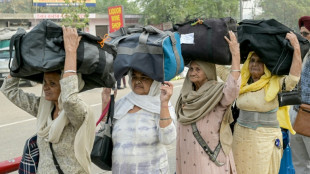

Why an Amazon chef said no to a vegan dinner for Prince William event
Saulo Jennings, a chef from Brazil's Amazon region, is so passionate about the rainforest's flavors -- like the massive pirarucu fish -- that he refused to cater a vegan dinner at an environmental awards ceremony hosted by Britain's Prince William.
The 47-year-old chef is, however, ready to impress heads of state at the COP30 meeting in the Amazon this week with an immersive dinner showcasing both plant and animal ingredients from the world's largest rainforest.
Jennings was appointed a UN gastronomy ambassador in 2024 and has cooked for presidents, diplomats, and even Mariah Carey.
Born and raised on the banks of the Tapajos River in northern Brazil, where he opened the first of his six restaurants 16 years ago, Jennings told AFP that sustainability, for him, is about balance.
Q - Why did you decide not to cook for Prince William and 700 guests at the Earthshot Awards dinner in Rio de Janeiro this week?
A - "The request I received was to create a 100% vegan menu, and I explained that I didn't feel comfortable signing off on such a menu because my work is precisely to show that the Amazon is sustainable, and this includes the fish.
"I even suggested making an Amazonian menu with mostly vegetable dishes, but also including sustainably managed fish, which ended up not being accepted.
"As far as I know, it wasn't a requirement of the royal family."
Earthshot declined to comment.
Q - Veganism has become synonymous with ethical eating, what do you make of this?
A - "I greatly respect those who choose this path. But I think it's dangerous when veganism is treated as synonymous with sustainability. They are different things. The forest is a balanced ecosystem, it needs people, animals and plants living together. What worries me is when this becomes a cultural imposition.
"The people of the Amazon are vegan, vegetarian and carnivorous without thinking specifically about it. We eat what the forest gives us. This relationship with food is ancestral."
Q - Initially some classic local dishes like acai, the Indigenous manicoba stew, and mouth-numbing soup tacaca, were banned from the COP30 menu over fears of contamination. What did you think about that?
A - "I was the first to question this, including with the Brazilian Minister of Tourism, and we managed to get a correction made to the bidding process. It would be absurd for the whole world to come and see the Amazon and for us not to be able to serve our own food.
"Many people from outside are still afraid of our food, and end up ordering chicken or turkey, when they could eat pirarucu (an Amazonian freshwater fish that can grow up to three meters long), which is noble, flavorful, and sustainable."
- Pirarucu as prestigious as ceviche -
Q - What Amazonian flavors are you bringing to COP30?
A - "The basis of everything for me is cassava...but I also love working with Brazil nuts, jambu (a herb which creates a tingling sensation in the mouth), melipona honey (from stingless bees), Santarem butter beans, pumpkin, banana, black tucupi (made from fermented and boiled manioc juice), and Marajo cheese (made from the milk of water buffalo).
"At COP, I want the world to taste these flavors and understand that the forest also speaks through food."
Q - Do you see Amazonian cuisine as a conservation tool?
A - "Absolutely. Cuisine is one of the most direct ways to protect the forest. When you consume sustainably managed fish, artisanal flour, or real tucupi, you are helping a chain that keeps people on the riverbank and prevents deforestation. Amazonian food is a political act of conservation."
Q - What has influenced your relationship with food?
A - "I am the son, grandson, and great-grandson of people who live off this land. Food for me is memory, it is resistance, and it is the most beautiful way to tell who we are.
"When we talk about the Amazon, there are still those who think it's exotic and don't understand that it's science, technique, and tradition. My dream is to see a pirarucu dish being served with the same prestige as a Peruvian ceviche or an Italian pasta."
C.Berger--NWT



